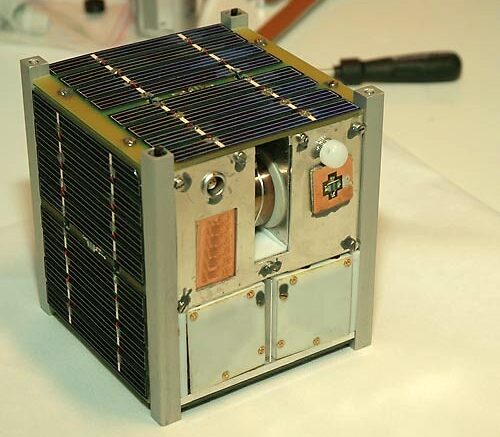A CubeSat is a type of miniaturized satellite for space research that is made up of multiples of 10 cm × 10 cm × 11.35 cm cubic units, which is roughly the size of ~ 4 in × 4 in × 4.5 in. This would qualify these satellites as U-class spacecrafts as CubeSats have a mass of no more than 1.33 kilograms or 2.9 pounds per unit. Common traits of these satellites is that they often utilize commercial off-the-shelf, often simplified to COTS, components for their electronics and structure.
History
The first CubeSats were developed by professors at California Polytechnic State University and Stanford University to promote and develop the skills necessary for creating small satellites intended for LEO operations. In the instance of the graduate students setting, the objectives were to design, build, test and operate limited capabilities of artificial satellites within the time and financial constraints of a graduate degree program.
The first launched CubeSats were placed into orbit in June 2003 on a Russian Eurockot, and since 2003, a total of roughly 100 CubeSats have been placed into orbit. From 2003 to 2013, the majority of the CubeSat launches were conducted by universities and research activities. However since 2013, over half of CubeSat launches have been for non-academic purposes with the majority of the deployed CubeSats are for commercial or amateur projects.
Benefits
Use cases will most likely involve miniaturized experiments or specific purposes such as Earth observation or amateur radio. At the NewSpace Conference in 2017, we heard an amazing idea to launch a large number of cubesats to monitor the weather to provide more localized weather data. forecasts. and have that data provided more often.
Other use cases are to demonstrate spacecraft technologies intended for small satellites or that present questionable feasibility. Therefore, by providing a testing ground for smaller scale experiments unlikely to justify the cost of a larger satellite, companies can save lots of money and better refine the technologies. Scientific experiments with unproven underlying theory may also find themselves aboard CubeSats because their low cost justify higher risks.
In some situations, because of their low risk and low costs, CubeSats represent a great first national satellite opportunity for currently non-space nations. The evolution and development of the CubeSat concept will change dramatically as there are several future missions to the Moon and beyond are in the planning stages. If successful, this will transform the idea of CubeSats from novel and niche idea to full blown concept. There is an idea for a cubesat company that will build, launch and maintain new satellites for anyone who has the funding.
https://www.nasa.gov/mission_pages/station/research/news/cubesats_possibilities
References and Further Reading
https://www.space.com/34324-cubesats.html

Be the first to comment on "CubeSats"